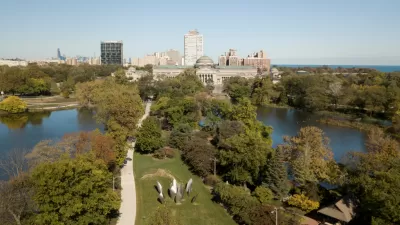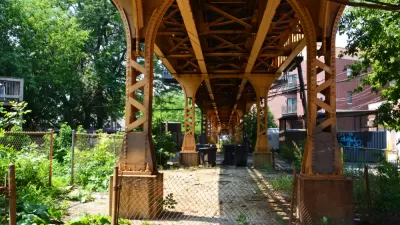The first project under Chicago’s Woodlawn Housing Preservation Ordinance is taking shape, aiming to bring new housing and retail to the neighborhood while avoiding displacement.
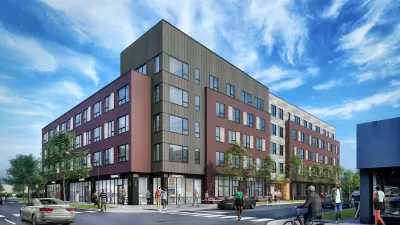
With their distinct histories and heritages, neighborhoods contribute to the culture of a city. Yet many of them are underserved, lacking access to necessary amenities and services. As architects, our role is to engage with cities in efforts to revitalize these neighborhoods, but the question we have to address is how to do so responsibly without contributing to displacement and economic disparity.
For decades, Chicago’s Woodlawn neighborhood faced a lack of economic development and amenities and, as a result, saw an increase in vacant lots. One of our firm’s latest projects, Park Station, is a multi-use development that will expand the supply of mixed-income housing options in the Woodlawn neighborhood. The Park Station project, led by The Michaels Organization and DL3 Realty, is a testimony to the power of public reinvestment and fostering a more inclusive, sustainable, and vibrant community.
Investing in affordable and existing housing
Affordable housing is a major topic of discussion in recent years as all major U.S. cities navigate population growth, skyrocketing rents, and shifting demographics. In the current market, building new affordable housing is cost-prohibitive without government assistance. Some jurisdictions are establishing affordable housing and neighborhood revitalization programs as one way to address community demands. Chicago adopted the Woodlawn Housing Preservation Ordinance in late 2020, which calls for more affordable housing for a range of incomes without displacing current residents. As the first multi-use development under this ordinance, Park Station will transform a formerly vacant lot and provide 58 new apartments, 70 percent of which will be affordable, with income limits between 30 percent to 60 percent of the Area Median Income (AMI). Policies such as the Woodlawn Housing Preservation Ordinance underscore the critical role of government assistance in revitalizing communities through housing. Interestingly, we find that residents want to see an increase in both affordable and market-rate housing to foster a more diverse and balanced neighborhood.
While the construction of new affordable housing can be tough to finance, another sustainable solution is to adapt existing housing. Older structures tell stories; they contribute to the historical character of a neighborhood. Thoughtful adaptive reuse of these buildings allows us to better preserve that culture and connection to the past while also ensuring they meet modern-day needs. Many older neighborhoods, particularly in Chicago, have a wealth of structures built in the 1920s and 1930s that don't meet today’s housing needs as they currently stand, but are worth maintaining and investing in.
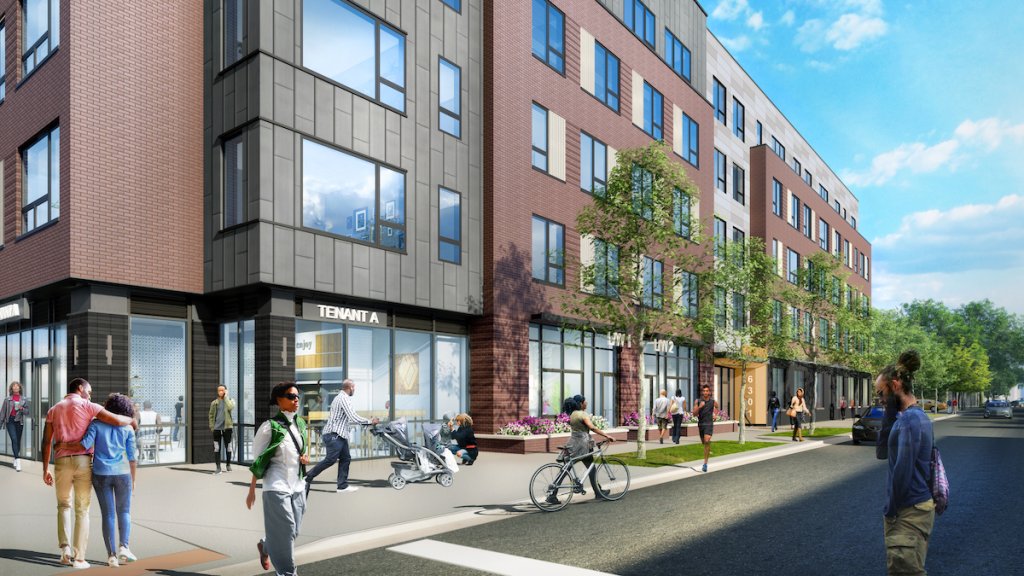
Mixed-use and transit-oriented developments
Thoughtful revitalization should extend beyond housing to address all aspects of resident well-being. This means integrating green spaces, retail, and community spaces into the fabric of these developments. It means considering how residents will access public transportation and the nearest healthcare facilities. In the Woodlawn neighborhood, there was a clear demand for more open space. Park Station incorporates a small park and a rooftop deck with city views, providing a much-needed natural respite and strengthening a sense of connection to the larger community. Park Station will also activate a commercial promenade with more than 3,500 square feet of retail space, helping achieve the city’s key goal of reestablishing 63rd Street as a neighborhood center. This in turn will increase job opportunities and encourage more growth.
Access to public transportation is also crucial for neighborhood development. Park Station is situated at an important intersection, just a block away from the CTA Cottage Grove Green Line stop and steps from bus service along 63rd Street. By locating residential projects near transit hubs and facilitating easy access to public transportation, we can reduce overreliance on private vehicles, promoting sustainability while freeing up land for additional buildings and open spaces. Park Station includes minimal spaces for car parking, but 50 spaces for bicycles, encouraging alternative modes of transport. Thanks to continued government investment, Woodlawn is becoming a more walkable community, with enhanced access to necessary services such as food and healthcare.
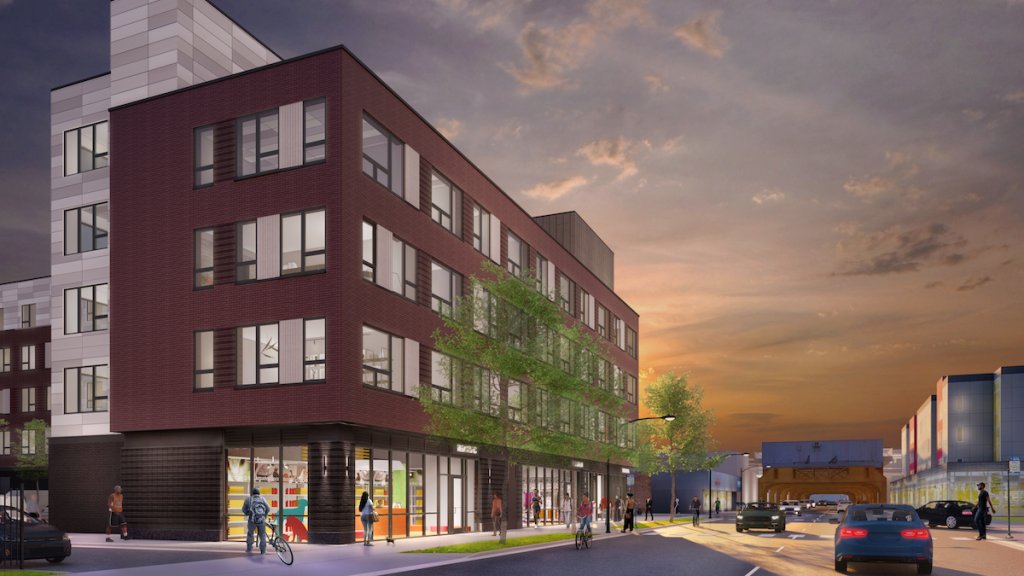
Just a block away from the CTA Cottage Grove Green Line stop and steps from bus service along 63rd Street, Park Station encourages alternative modes of transport and reduces overreliance on private vehicles—promoting sustainability while freeing up land for additional buildings and open spaces.
Fostering stronger communities for a more promising tomorrow
Responsible neighborhood revitalization goes beyond the built environment. It requires an understanding of a community's cultural, social, and economic fabric. This insight provides the foundation for revitalization projects that will preserve the identity of a neighborhood while providing residents with the resources they need to live better lives. Projects like Park Station and the larger Woodlawn Housing Preservation Ordinance showcase what is possible when cities choose to reinvest in neighborhoods that have been historically overlooked. As architects, we are excited to have these opportunities to contribute to the health and wellness of our communities for generations to come, and to play a part in stimulating neighborhood growth and development.
Richard Whitney is Vice President at FitzGerald. A leader in the firm’s pursuit of senior housing, affordable housing, and hospitality projects, Rick helps developers and owners realize their vision for their multifamily communities, hotels, conference centers, and restaurants. He is a champion of the firm’s belief that the adaptation and rehabilitation of older buildings is a viable and effective course of action to energize the performance of existing assets.

Study: Maui’s Plan to Convert Vacation Rentals to Long-Term Housing Could Cause Nearly $1 Billion Economic Loss
The plan would reduce visitor accommodation by 25,% resulting in 1,900 jobs lost.

North Texas Transit Leaders Tout Benefits of TOD for Growing Region
At a summit focused on transit-oriented development, policymakers discussed how North Texas’ expanded light rail system can serve as a tool for economic growth.

Using Old Oil and Gas Wells for Green Energy Storage
Penn State researchers have found that repurposing abandoned oil and gas wells for geothermal-assisted compressed-air energy storage can boost efficiency, reduce environmental risks, and support clean energy and job transitions.

Private Donations Propel Early Restoration of Palisades Playground
Los Angeles has secured over $1.3 million in private funding to restore the Pacific Palisades playground months ahead of schedule, creating a modern, accessible space that supports community healing after recent wildfires.

From Blight to Benefit: Early Results From California’s Equitable Cleanup Program
The Equitable Community Revitalization Grant (ECRG) program is reshaping brownfield redevelopment by prioritizing projects in low-income and environmental justice communities, emphasizing equity, transparency, and community benefits.

Planting Relief: Tackling Las Vegas Heat One Tree at a Time
Nevada Plants, a Las Vegas-based nonprofit, is combating the city’s extreme urban heat by giving away trees to residents in underserved neighborhoods, promoting shade, sustainability, and community health.
Urban Design for Planners 1: Software Tools
This six-course series explores essential urban design concepts using open source software and equips planners with the tools they need to participate fully in the urban design process.
Planning for Universal Design
Learn the tools for implementing Universal Design in planning regulations.
Ascent Environmental
Borough of Carlisle
Institute for Housing and Urban Development Studies (IHS)
City of Grandview
Harvard GSD Executive Education
Toledo-Lucas County Plan Commissions
Salt Lake City
NYU Wagner Graduate School of Public Service


























